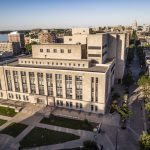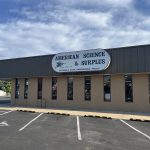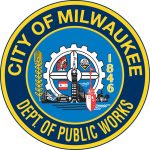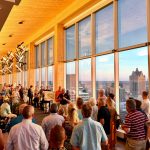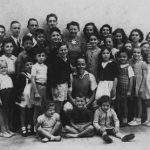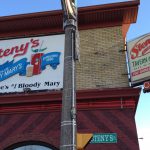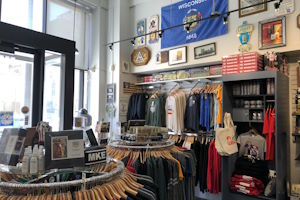2003
Rivers, Railways and a Greener Milwaukee
By Matt Czarnik Milwaukee, a city built on the edge of a Great Lake and fed by the convergence of three major waterways, each supporting its own diverse and extensive natural habitat of flora and fauna, is a land capable of creating and sustaining many forms of life. Follow the ancient formula that gave birth to civilization and you’ll find that where the rivers run and spread streams into the land, people have flourished, formed cultures, developed systems and made their histories along the waterways. But gone are the days when the first settlers forged their existence by maintaining a symbiotic relationship with the earth’s precious resources, and modern humans wince at the lost motto of beauty in simplicity. In remedy, they must work with the concrete world they’ve created. For Milwaukeeans it’s not a secret how the land and waterways have been punished by the industrial age. You need only watch the water flowing through the city during the spring thaw or smell the air in summer when it mixes with the fumes escaping from the rivers and Lake Michigan. But too often, the scars left by commerce are viewed only from a distance by drivers passing over viaducts, not looking long enough to wonder what’s gone wrong and not troubling themselves to learn what’s being done for the future. But when a state’s identity (not to mention economic survival) relies on the health of its natural resources for shaping itself as a vacation destination and sanctuary for wildlife and wildlife-watchers, the idea of the state’s most populous city not guiding the conservation and preservation efforts has motivated some people to act to protect the environment on behalf of the people. Leading the recovery revolution Leading a coup d’etat for the environment is a challenge undertaken by many different, groups, from non-profit entities like the Friend’s for Milwaukee’s Rivers, the River Revitalization Foundation (RRF) and Menomonee Valley Partners, Inc., to city, county and state agencies like the Department of Natural Resources (WDNR) and local neighborhood associations. Two projects currently receiving funding on the local and federal levels, as well as private donations from partnerships and non-profit fundraising, are the proposed Beerline County Trail as an extension of Gordon Park in the historic Riverwest neighborhood and the Hank Aaron State Trail (HAST) which follows the Menomonee River from the city’s west side to Lakeshore State Park. Both will be located along the banks of rivers, the Beerline along the west bank of the Milwaukee and HAST along the Menomonee. Both are in the early stages of multi-year plans to build paved city trails that will link urbanites to recreational amenities throughout the city. Each is unique in design and location, but similar in what they offer to the revival of the water basin. The Beerline County Trail In 1987, former Governor Tommy Thompson created the Milwaukee River Revitalization Council, which, after extensive research, published the Riverway Plan. This document advises the WDNR, and stipulates that certain actions be taken to […]
Apr 1st, 2003 by Vital ArchivesThe Belles
By Jeremy Saperstein I’m pretty sure I’ve sworn off nice pop records a hundred times. Some sort of social consciousness bug invades my system and I swear I’ll never listen to simple lyrics of love again. But I always crack. Omerta is a fine record to crack to. The Belles are, surprisingly, only a duo – Christopher Tolle and Jake Cardwell – from Lawrence, Kansas (the stomping grounds of American pop legends The Embarassment), but the sound is anything but sparse. Filled with power-pop and indie-rock allusions, the record will get a lot of references to other bands whose name start with ‘B’ – Beatles, Big Star, Beach Boys – and that’s not a bad comparison. The opener, “So, I Sing” is a bit of chamber-pop with what sounds like a mellotron and some gorgeously lush backing vocals, while “You Can’t Have It All” rocks with a bit of acid lead guitar seemingly lifted directly from a Buffalo Springfield record.
Apr 1st, 2003 by Vital ArchivesRemedies for Spring’s Strains and Pains
By Jan Wolfenberg Spring is upon us, and for many, this means a sudden increase in physical activity. It’s common to greet the warm weather and bright sunshine with a generous portion of over-enthusiasm. We are all so eager to shake off the winter cobwebs and get outside! Whether gardening, golfing, or just spring-cleaning, the sudden shift away from winter’s sedentary habits can put some stress on our bodies, which we often notice in the form of aches, pains, bruises, strained muscles and sprained joints. Western medicine offers us analgesic relief in the form of over-the-counter medications like aspirin, acetaminophen and naproxen sodium (brand names omitted), as well as prescription pain relievers. But these acute conditions can usually be helped greatly by a handful of natural options that have fewer side effects and tend to work with the body instead of against it. Give yourself a break First of all, if you are sore from over-doing, it is your body’s way of telling you to give it a break. Muscles that are strained from overuse need a day or two to recover. If there is swelling that accompanies any strain or sprain, cold packs can significantly reduce soreness while alleviating swelling. Pain relievers only mask the symptoms; they don’t cure the condition, which only wants time to heal. With your symptoms masked, you are out of touch with your body’s signals, and this permits you to continue pushing yourself instead of taking the time you need to recover. Trust your body’s wisdom and listen to its signals. Second, drink plenty of fluids and eat healthy foods. Healing tissues need to remain well hydrated, and sufficient fluids also provide a way for toxins to be excreted. Stick to water, pure fruit juices and herbal teas. Soda pop only burdens the immune response and slows healing, while fruit juice cocktails aren’t much better. In fact, white sugar and corn sweeteners (found in most convenience foods) are very hard on the body in general, and especially so during healing. Choose natural foods that are minimally processed, and include lots of fruits and veggies. These foods provide your healing tissues with the building blocks they need to repair themselves. Third, don’t forget to utilize good health care practitioners who perform body work. Chiropractors can help re-align anything that needs it and are often covered by health insurance. Massage therapists can loosen tight muscles, facilitate lymphatic drainage of toxins and encourage tissue healing while providing you with a one-hour vacation from your hectic new spring schedule. Your chiropractor or massage therapist may be able to recommend specific stretches or exercises, both to aid in healing this injury and preventing one in the future. If you’ve never worked with either of these types of professionals, ask your friends for referrals. Word-of-mouth recommendations are often the best way to locate a good practitioner. Natural Remedies Nature also provides some curative herbs and minerals that we can use to help our bodies heal the effects of overuse. Two […]
Apr 1st, 2003 by Vital ArchivesThe Kids Are Alright
By John Hughes These are violent and disturbing times. With war and terrorism looming over our heads, the economy slumping and personal depression seemingly at a new high, there is more than enough to worry about. Also, the roaring din of celebrity glitter and the avalanche of plastic entertainment can leave a person feeling estranged. Yet, there is always hope, and the root of our hope is in the human spirit itself, ever renewing, perhaps even evolving over the eons. As the English poet Gerard Manley Hopkins once put it, “There lives the dearest freshness deep down things. “Perhaps that’s a little hard to see these days, but it is evident if you look hard enough. Vital Source, in a series of three interviews with five Milwaukee teenagers, found glimpses of that dearest freshness. They are Sam and Simon Barcelona, Xanthia and Alexandra Walker, and Lee LaMar; a diverse quintet, who hold as a common trait their joie de vivre, their joy of life. They are remarkable young people in our midst, and their lives refresh hope. There are good people in Milwaukee, who are ethical, fun, interested in life, making their own ways with thoughtfulness and sensitivity. They love their families, their friends, and each other. These five all share an inner peace mixed with a zest for the future, and a determination to be themselves in the face of peer pressure. It was our privilege to be in their presence. We are pleased to introduce you to them. The Barcelona brothers Sam and Simon Barcelona, ages 17 and 14, are seated in their Wauwatosa living room, looking serious for the media. They are discussing conformity to peer pressure. They are against it. “It’s more fun to be yourself than someone else,” says Sam. “I hate how you see kids at the school, and these people are from Wauwatosa, and they’re trying to be hip-hop heroes. That’s so overrated. It’s so artificial. And drugs are just huge at Tosa East. I don’t support that. It’s their choice, of course, but I’m not going to join �em. I watched other people and saw their mistakes, and I’ve learned enough about that. I don’t want it.” He is a handsome young man with dark features and long sideburns that remind me of Elvis Presley’s. When I asked if they were in tribute to the King, he laughed and reported that he doesn’t like Elvis. He prefers punk rock, which he describes as good clean energy. Simon, who attends Marquette High School as a Freshman, concurs with Simon about conformity. “It’s a bummer how everybody tries to fit in. Everybody’s holding back all the time. I don’t believe in holding back. Sam and I like to find people that don’t care what people think, and hang with them. It’s better that way.” These two young men are talkative and serious, answering my questions with thoughtfulness and deliberation. As Simon tells me that he’d like to become a pilot, possibly after attending the […]
Apr 1st, 2003 by Vital ArchivesThe Immigrant Student Reality
By Erin Stalnaker Proposed tuition hikes have UW students and faculty up in arms, and rightfully so. But the increase, while steep, is still only 7�o 9.4�depending on the campus and undergraduate or graduate status. So imagine the ire of students and parents alike if 2003-04 tuition rates increased 441�from $3,738 per year to $16,490. In this scenario, many students wouldn’t be able to continue their education and would end up in the non-professional, low-paying jobs traditionally filled by workers without college degrees. The immigrant student reality For most people, this seems far-fetched. But for non-resident immigrant students it’s reality. These young people must pay the out-of-state tuition rate even when they have attended Wisconsin schools from kindergarten through the 12th grade. Many graduate at the top of their class, and consider Wisconsin their only home, having lived here since the age of five or even younger. Most of these children’s parents have paid taxes throughout their residency in the state; these young people are deeply rooted here and have the potential and desire to contribute greatly to their communities. The Two Elizabeths My name is Elizabeth. I am 17 years old, and a senior in a south side high school. I came to the United States when I was 12 years old; my parents, brother and I crossed the border with visas. Since 7th grade I have always held a 3.5 G.P.A. Now that I am about to graduate and want to go to college I realize how difficult it will be, since I am not a U.S. citizen. My long-term goal is to become an immigration lawyer because I would like to fight for the justice of immigrants. Now, not only my future, but also the futures of other immigrant students who are seeking fairness and opportunity are in the hands of voters. My name is Elizabeth, and I am 16 years old. I am currently a junior in high school. Since I was small, my dream has been to be the first in my family to get a college education. Due to my legal status, it seems like a dream impossible to fulfill. I came to the United States eight years ago with my family because of poverty in Mexico. Living there, it became harder for my parents to pay for our expenses. My father decided that the best thing to do would be to cross the border illegally so he could work to send money to my mother in Mexico. When I came to this country, I knew I wanted to change my social structure and confront the stereotypes of Latinos in this country. I have a 3.0 GPA, and I enjoy volunteering. I want to become a productive adult member of my community; without an education, it is more likely that I will work in a low paying job. Two voices among many These are the voices of but two of the thousands of bright immigrant students who have the ability and the desire to […]
Apr 1st, 2003 by Vital ArchivesThe “Other” Baseball
By John Hughes There you sit, at Miller Park again. The new leaders – Payne, Melvin and Yost – have made a good impression on you, and so, as an act of faith, you have trekked out to the ballyard and paid dearly for parking, tickets, peanuts and Cracker Jack. You are seated in this vaulted structure, which, despite the leaky creaky roof, impresses you. The losing doesn’t torment you like it once did, because by now it’s as familiar as a March blizzard in Milwaukee. But even amidst all the splendor Brewers baseball has to offer, you’re still feeling bad. If you are any sort of baseball fan, this is a scenario not unlikely to play itself out in your life soon. The 2003 season begins while this edition of Vital Source is on newsstands. The Brewers will resume play and you will find yourself watching them, thinking “what is wrong with this picture”? And if you give it a moment’s thought, the answer will come. For all the talk about the market offering the price it’s willing to bear, about these players just getting what they can as anyone else would, it troubles you that they are paid so much. True, it is just one symptom of a greater illness – the mass profiteering of professional sporting organizations on every front, from palatial stadiums to insane merchandising – and salaries are just another side effect. But the magnitude of their income, compared to the rest of us, seems a dishonorable allocation in a sport to which the majority of Americans, most working class, once felt a deep connection. The Brewers’ payroll this year will be roughly $50 million. Their opponents, on any given day, will have a payroll varying from $50 million to over $100 million. So, with 25 on each team, that’s 50 athletes out on the ballfield you’re observing, making $100 million to $150 million, or higher, for laboring from mid-February, with the beginning of spring training, until October 1st, or, if they’re quite good, until around November 1st when the World Series ends (and they are awarded an enormous bonus). That is a stupendous sum of money. In a world in which school teachers and nurses and social workers and construction workers and waitresses do heroic feats daily, and face budgetary pain nightly, to see young men making that sort of money, without even passion to offer fans, makes you feel like an accomplice to a crime each time you pay for your ticket, each time you pay $5 for a macro-beer. The yearning for passionate baseball If you’ve been a fan awhile you can remember Clemente, Yount, Yastrzemski, Aaron, Munson and Seaver, can remember the passion they poured into their treasured craft, and what it felt like to revel in their joy. Now, you feel nausea, or worse, echoes of the ennui that permeates the field below as you watch now. In comparison, players today mostly seem like poseurs, who would rather be at […]
Apr 1st, 2003 by Vital ArchivesApril 2003
Dear Readers, Between the time this issue of Vital Source was created and actual press time, America entered into war with Iraq. This is one of the disadvantages of being a monthly publication, and our lack of coverage of the war and its implications, for April anyway, cannot be helped. For May, I would love to share reader letters and short essays on the war, especially from people whose lives are directly touched. Please send all correspondence to editor@vitalmilwaukee.com, or by mail to the address in the staff column. The war is being televised, and things are happening quickly. While I feel confident we’ll never fail to support our troops again (a la Vietnam), there are underpinnings to this particular conflict that, if unchecked, will bring fundamental changes to our democracy. In an increasingly technological world, access to information is the key to power. But the stripping of personal freedom and overt censorship are not the answers. Individual liberty, access to due process, and innocent until proven guilty are the cornerstones of our Constitution. Fundamentally, we as a nation agree on two key points: we want our men and women home quickly, and a swift end to the war. But we must take care that, in our zeal to “end oppression” in the Middle East, we do not eliminate oppression’s most powerful natural enemy – a nation of free peoples – our nation, the United States of America, and the democracy for which it stands. A perfect snapshot of our confusion occurred on Oscar Night. Michael Moore, in his acceptance speech for Best Documentary, was met with a mix of boos and cheers (boos were later mostly attributed to Teamster crew members) when he said (speaking on behalf of himself and others present onstage): “… we live in fictitious times. We live in a time when we have fictitious election results that elect a fictitious president… We live in a time where we have a man sending us to war for fictitious reasons, whether it’s the fictition (sic) of duct tape or the fictition (sic) of orange alerts, we are against this war, Mr. Bush.” All Oscar winners are technically given 45 seconds to speak from the stage. At precisely 45 seconds, Moore’s microphone was cut mid-sentence and the orchestra began to play. Conversely, Richard Martin’s acceptance speech for Chicago ran well over a two minutes, but contained no political references. He was not cut off. And even though Adrian Brody mentioned the war in his four minute accectpance speech, he only went so far as to wish a speedy end to the conflict and to express his support of the troops. Brody was also not censored. This may seem a small event, but all who watched the Oscars witnessed censorship first hand. We must pay attention to these breaches of free speech, whether or not we agree about their content. Consensus is not the point. Free speech is at risk. Please read Paul McLeary’s We The People. It covers […]
Apr 1st, 2003 by Jon Anne WillowKelp Chofs Takes GbV on The Road Less Traveled
By Kelp Chofs Sweat. Grime. Arms. Legs. Face. Had the air-conditioning even been working in John’s ’80’s-something Toyota it may not have done much good on that sweltering day in the Summer of ‘97. John and I were bandmates (and still are) driving out of St. Louis toward a show in Iowa City. Were we on tour? Well, technically not. We had left our hometown of Milwaukee the day before to catch a show in St. Louis. Another band’s show. A Guided By Voices show. My first. The plan was to catch GbV (as the hip refer to them) then motor away toward Iowa City to dish out our own brand of rock and roll. The rest of our band would catch up with us there. For me, the soundtrack for that weekend was GbV’s Mag Earwhig! It was the latest addition to their already stunning catalog. That made it a top-pick among their other releases and bootlegs littering the car floor among the remnants of our fast-food sins. After settling into a particularly, um, quaint St. Louis Motel 6, we headed over to the club early for lack of anything better to do. Arriving early did serve a purpose — we had to buy tickets. Well, I did. John had gotten his online before we left. Yup, I was the last-minute addition to his plan. I remember the city streets being exceptionally quiet during those dusk hours. Businesses were all closed for the most part. Hell, we had to walk a mile just to find a bar that was open. We certainly weren’t in Milwaukee anymore. “Two Rolling Rocks, please.” We walked back to the club to find the box office still closed. But John did spot Pete Jameson. Pete was GbV’s right-hand man. Surely if we struck up a conversation with him, explaining how we’d driven 400 miles to the show, he’d make sure I got a ticket. As it turned out, the show was nowhere near sold-out. But as we were to find out, that was a good thing. St. Louis’ The Galaxy club was much smaller than I imagined it. But that was also to be a good thing. After tolerating the unusually pedestrian opening act, GbV began to set up. Who were they? Who played what? Is that Pete Jameson putting an ice-filled cooler of Rolling Rocks on the drum riser? The show started, guitars and cigarettes blazing. Never before had I been treated to such an intimate and powerful rock ‘n’ roll show. This was it. This was the real thing. The intensity. Right in front of me. I could touch it. I could barely contain myself. Wicked voodoo indeed. “Two Rolling Rocks, please.” “Two Rolling Rocks, please.” “Two Rolling Rocks, please…” John and I made several jokes on the trip down about his training me for this show – making sure I was familiar with most of the songs GbV might be performing. And a fine job he did. The revolving door of […]
Apr 1st, 2003 by Vital Archives




